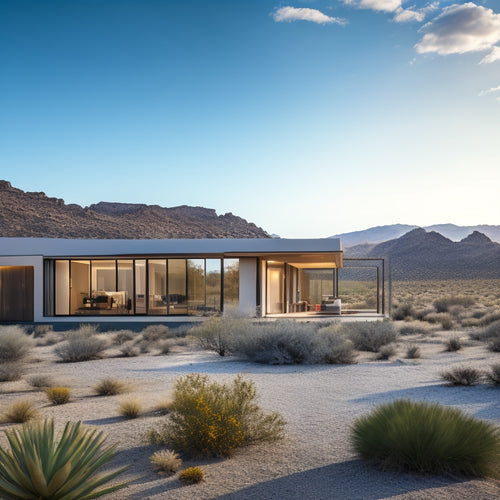
7 Pool Heating Hacks Using Clean Energy Systems
Share
You can upgrade your pool heating system to leverage clean energy and reduce your carbon footprint. Employ solar panels at ideal angles to maximize energy absorption, and consider heat pumps that can deliver up to 4 units of energy for every unit of electricity consumed. Implement energy efficiency strategies, such as smart sensors and automation, to enhance system performance. DIY solar pool heating systems and thermal covers can also improve heat retention. To take it to the next level, investigate smart pool heating controllers and low-cost solar heat maintenance. By incorporating these hacks, you'll be well on your way to a sustainable and cost-effective pool heating solution that's customized to your needs.
Key Takeaways
- Optimize solar panel angles at 30-40 degrees to maximize energy absorption and increase energy yield by up to 10%.
- Implement heat pumps that deliver up to 4 units of energy for every unit of electricity consumed, reducing fossil fuel reliance.
- Utilize DIY solar pool heating systems with durable materials and tailored installation for a cost-effective and sustainable solution.
- Leverage thermal covers with reflective and insulating materials to minimize heat loss through evaporation and conduction.
- Invest in smart pool heating controllers that automate temperature control, optimize heating efficiency, and provide real-time energy monitoring.
Harnessing Solar Power Efficiency
Optimize your pool heating system by capitalizing on the free energy source available right above you - the sun.
You can utilize solar power efficiency by strategically placing solar panels at an angle that maximizes energy absorption. Proper solar panel placement is vital, as it directly affects energy conversion efficiency, with high-efficiency solar panels offering conversion rates up to 23% for enhanced energy yield.
Additionally, panel angle optimization can enhance energy yield by up to 10% by adjusting to seasonal changes. Aim for a 30-40 degree angle to capture the ideal amount of sunlight. This will enable your solar panels to convert sunlight into heat with maximum efficiency.
By doing so, you'll reduce your reliance on traditional energy sources and enjoy a significant decrease in your energy bills.
Take control of your pool heating system and release the power of clean energy today!
Heat Pump Technology Explained
Almost 75% of pool owners rely on traditional heat sources, such as gas heaters or electric resistance heaters, which can be costly and environmentally detrimental.
You can break free from these constraints by utilizing the power of heat pumps. Heat pumps are highly efficient and can provide up to 4 units of energy for every unit of electricity used.
As the world shifts towards renewable energy integration, it's crucial to adopt clean energy solutions like heat pumps. This not only reduces our reliance on fossil fuels but also helps create a sustainable future.
-
Environmental benefits: Heat pumps are a clean and eco-friendly way to heat your pool, reducing your carbon footprint and promoting sustainability.
-
High efficiency: Heat pumps can achieve efficiencies of up to 400%, compared to traditional heat sources.
-
Variety of heat pump types: You can choose from air-source, water-source, or ground-source heat pumps, depending on your specific needs and preferences.
Maximizing Energy Savings Potential
You can maximize your pool heating system's energy savings potential by implementing energy efficiency strategies, such as optimizing pump schedules and insulation.
Additionally, cost-effective solutions like smart sensors and automation systems can help you identify areas of inefficiency and make data-driven decisions.
By incorporating sustainable infrastructure and reducing fossil fuel dependence, you can also mitigate volatility in fuel prices and enhance operational efficiency.
Energy Efficiency Strategies
Embracing energy-efficient strategies is vital to minimize the environmental footprint and reduce energy bills. As you investigate ways to heat your pool using clean energy systems, it's imperative to adopt sustainable practices that optimize energy savings.
Conducting energy audits, for instance, can help identify areas of energy inefficiency and opportunities for improvement in your pool's heating system, much like how renewable energy solutions can reduce fossil fuel reliance and carbon footprint. Furthermore, integrating hybrid electric solutions can lower emissions and improve fuel efficiency.
To maximize your energy savings potential, consider the following strategies:
- Conduct energy audits: Identify areas of energy inefficiency and opportunities for improvement in your pool's heating system.
- Implement energy-efficient equipment: Upgrade to energy-efficient pool pumps, filters, and heaters that consume less power.
- Optimize system operation: Adjust your pool's heating schedule and temperature to minimize energy consumption during off-peak hours.
Cost-Effective Solutions
By adopting energy-efficient strategies, you've already taken a considerable step towards reducing your pool's environmental impact and energy expenses.
To maximize energy savings potential, consider cost-effective solutions that integrate clean energy systems, such as incorporating renewable energy sources like solar and wind power into your pool heating system. A solar panel installation can considerably reduce your reliance on traditional energy sources, slashing your pool heating costs.
Additionally, energy usage monitoring systems can help you identify areas of inefficiency, allowing you to optimize your pool's energy consumption.
By leveraging these solutions, you can enjoy a warm and inviting pool while minimizing your environmental footprint and saving money on energy bills.
With the right combination of clean energy systems and smart monitoring, you'll be swimming in energy savings in no time.
DIY Solar Pool Heating Systems
Within the domain of clean energy systems, DIY solar pool heating systems have emerged as a cost-effective and eco-friendly alternative to traditional pool heating methods.
You can take advantage of free solar energy to heat your pool, reducing your reliance on fossil fuels and saving money on your energy bills.
Here are three essential considerations for designing and installing a DIY solar pool heating system:
-
Optimize solar panel installation: Make certain your solar panels are installed at the correct angle and direction to maximize energy absorption.
-
Design a DIY system that suits your pool: Consider your pool's size, shape, and location when designing your solar heating system.
-
Choose the right materials: Select durable, heat-resistant materials for your solar collectors and pipes to guarantee efficient heat transfer.
Boosting Heat With Thermal Covers
You're likely aware that a significant amount of heat is lost through evaporation, but you can minimize this loss by implementing effective heat retention strategies.
Thermal covers are a great solution, and the material you choose plays a vital role in their performance.
Heat Retention Strategies
Your pool's thermal energy is constantly being drained by heat loss, but thermal covers can be a revolutionary element in heat retention strategies.
By implementing the right techniques, you can minimize heat loss and maximize your pool's thermal energy. Here are three key heat retention strategies to take into account:
- Insulation techniques: Properly insulating your pool's pipes, pumps, and equipment can greatly reduce heat loss.
Look for areas where heat may be escaping and apply insulation materials as needed.
-
Nighttime practices: Develop good nighttime practices, such as running your pool's filtration system during off-peak hours and using a thermal cover to trap heat.
-
Cover maintenance: Regularly clean and maintain your thermal cover to guarantee it remains effective in retaining heat.
A well-maintained cover can make a considerable difference in your pool's temperature.
Cover Material Options
By incorporating thermal covers into your heat retention strategy, you've taken a significant step in minimizing heat loss and maximizing your pool's thermal energy.
Now, it's crucial to choose the right cover material to optimize heat retention. Reflective pool covers are a great option, as they reflect heat back into the pool while keeping debris out.
Insulating cover materials, such as foam or vinyl, provide additional thermal insulation, reducing heat loss through conduction.
When selecting a cover material, consider factors like durability, ease of use, and maintenance requirements.
Smart Pool Heating Controllers
Most pool owners find themselves struggling to maintain a comfortable water temperature, especially during periods of low sunlight or extreme weather conditions.
You're likely tired of manually adjusting your pool heater, only to waste energy and money. That's where smart pool heating controllers come in. These innovative systems optimize your pool's temperature using advanced algorithms and real-time weather forecasts.
Here are three ways smart controllers can revolutionize your pool heating experience:
-
Automated temperature control: Smart thermostats learn your schedule and preferences to maintain the perfect temperature, even when you're not around.
-
Real-time energy monitoring: Stay on top of your energy consumption and identify opportunities to reduce your carbon footprint.
-
Optimized heating cycles: Smart controllers adjust heating cycles to minimize energy waste and maximize efficiency, saving you money and the environment.
With a smart pool heating controller, you can enjoy a comfortable pool temperature while maintaining your freedom from energy waste.
Low-Cost Solar Heat Maintenance
The solar heat maintenance system is an essential component of your clean energy pool heating setup, guaranteeing ideal performance and longevity.
You'll want to prioritize routine maintenance to maximize your solar panel installation's efficiency. Start by inspecting your panels regularly for debris, dirt, or damage. Clean them gently with a soft brush and mild soap to prevent energy absorption reduction.
Check the system's pipes and fittings for leaks or corrosion, and replace them if necessary. Confirm proper insulation to minimize heat loss.
Frequently Asked Questions
Can I Install a Solar Pool Heating System Myself?
A million DIY enthusiasts have attempted to tackle the task, but can you really install a solar pool heating system yourself? Yes, with some technical savvy, you can steer through the DIY installation process, choosing between monocrystalline and polycrystalline solar panel types.
Are Heat Pumps Suitable for Small Swimming Pools?
You'll find heat pumps suitable for small swimming pools, as they offer high heat pump efficiency and capitalize on small pool advantages like faster heating and lower energy bills, giving you the freedom to enjoy your pool year-round.
Do Thermal Covers Work With Saltwater Pools?
You'll be pleased to know that thermal covers work seamlessly with saltwater pools, preserving the benefits of saltwater sanitizing while maintaining thermal cover effectiveness, allowing you to enjoy your pool's warmth and cleanliness with utmost freedom.
Can Smart Controllers Integrate With Existing Pool Systems?
You can seamlessly integrate smart controllers with your existing pool system, leveraging smart technology to optimize energy efficiency and automate tasks, giving you more freedom to enjoy your pool while minimizing your environmental footprint.
Are Solar Heat Maintenance Costs Tax-Deductible?
Fasten your seatbelts, time-travelers! When you install solar heat, you'll be cruising towards tax benefits. You'll find maintenance tips are key to maximizing those deductions; keep records of filter cleaning, pump replacements, and system checks to claim those sweet tax breaks, freeing up cash for your next journey!
Related Posts
-

7 Best Geothermal Cooling Systems for Hot Climate Homes
You're evaluating geothermal cooling systems for your hot climate home, and you want to know the top options. Look fo...
-

Why Choose Solar Composting Toilets for Your Home?
By choosing a solar composting toilet for your home, you'll greatly reduce your environmental impact, slashing your w...
-

Why Grow Up? Vertical Gardens Transform Urban Living
As you change your urban living space, you're not just growing up - you're bringing nature back into the heart of the...


